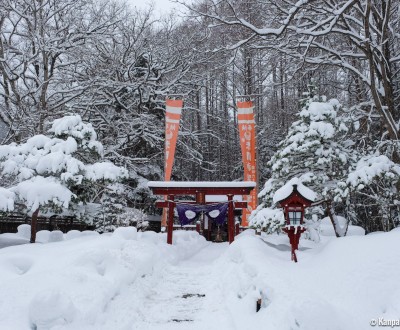Yunishigawa Onsen
The winter magic in the north of Nikko
Yunishigawa Onsen is a thermal resort located in the north of Nikko city, in Tochigi prefecture. The village is totally covered in snow in winter and a fairytale-like scenery awaits as night falls on the village and its illuminations during the winter Kamakura snow huts festival. The daytime is ideal to discover Heike-no-sato’s history, and to relax in one of the natural hot springs.
In the heart of Kanto’s mountains, Nikko spreads on a vast area of almost 1,500 square kilometers, at an average altitude of 1,300 meters above sea level. The north of the city gathers several thermal facilities renowned for their therapeutic waters; among which is Yunishigawa Onsen ♨️, sitting in the most remote location. Nestling in a secular cedar forest on the shores of Yunishi River, the village borders the Tohoku region.
The best season to discover this thermal gem is in winter, when snow is plenty and the cold weather well established. The traditional facilities and hostels offer an astounding natural and relaxing landscape. This description fits well the Irodoriyukashiki Hana-to-Hana ryokan, which provides outdoor baths-featured rooms, and a view on the surrounding forest, whose nightly light-up offers a mystical atmosphere. Dinner is a must-eat for its originality and the quality of the Japanese service. Sitting around a irori hearth, guests can enjoy the excellent local cuisine with a taste of history, as the Taira (or Heike) clan’s warriors used to cook the same way when they sought refuge in the region at the end of Heian period (794-1185).

Heike-no-sato is a reconstructed village, with characteristic thatch roofs, and an outdoor museum. Apart from the baths, it is the only touristic attraction of the resort. Heike samurais’ everyday life is recounted as they came to hide and heal their injuries in these secluded mountains after their defeat in the Genpei war against the Minamoto clan in the 12th century. A dozen of traditional houses are thus open to the visit, allowing to stroll in the village between a small shrine and the inside of the buildings.
In winter, Yunishigawa Onsen’s village becomes the main site for Kamakura festival. From the end of January to the beginning of March, a special, charming atmosphere oozes from the onsen resort. Along the shores of the river, the inhabitants build several hundred of Japanese style snow huts, named kamakura, wonderfully lit up with candles. In Heike-no-sato Park, numerous snow huts are aligned, with various sizes from the tiniest ones to some accommodating human activity.
Amateurs of winter sceneries are immersed in a timeless atmosphere where snow is magnified by night illuminations. Some other light and snow festivals also happen here and there in Nikko. The city is a nice winter destination, where the few tourists can enjoy the omnipresent nature when it seems asleep, if they are daring to brave snow and cold weather.

